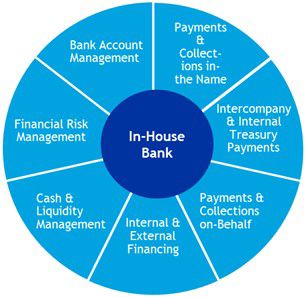In-house banking has emerged as an increasingly important tool for companies to streamline some of their key financial operations and minimize risk. In recent years in particular, the level of interest from companies has risen sharply and there have been some interesting trends and developments in this area.
Given that the term in-house bank is used very differently in literature, industry and the treasury management system (TMS) market, let's start with a definition that is as practical as possible. By in-house bank, we mean a group of essential services (shown below) which companies typically obtain from an external bank, which are instead made available to the company and its subsidiaries via an internally operated counterpart, the in-house bank.
Fig. 1: In-house bank

Source: KPMG AG
Across all industries, the following four key trends are evident in the functional areas presented, which can be divided into system and functionalities, compliance, data quality and cash management integration.
1. Technological innovations
The in-house bank as an integrated part of a TMS
Over the last few years, the traditional providers of treasury management software in particular have invested heavily in the in-house bank segment. The respective modules in this area have become more technically mature and have a wider range of functions than a few years ago. User convenience is also improved and the options for integration into other modules, such as daily planning, liquidity planning or reporting, are now fully developed. All of these developments facilitate and shorten the technical implementation.
=> Market maturity: high
Integration of payment and trading platforms
The second stage of technical innovation is the integration of various external platforms for virtual credit cards, digital wallets and the first cryptocurrencies into in-house banking systems. This allows payments to be processed more quickly and international transactions to be carried out more cost-effectively. Even integration with trading platforms has become even more convenient. Most TMS providers have a standardized API to the platforms, which saves companies from having to operate their own interface.
=> Market maturity: medium
Artificial intelligence & co.
When it comes to innovative technologies, there are already initial prototypes that could soon be ready for the market. Predictive analytics with the support of AI for liquidity planning, account statement processing, risk management and reporting are some of the already known use cases from treasury. The use of blockchain for communicating with banks is another. One interesting aspect here is the first productive proof of concept of a company's own blockchain-based coin for settling internal receivables and liabilities. However, despite the seemingly high potential for treasury, driven by media attention, system providers and companies are still in the development phase.
=> Market maturity: low
2. Stricter compliance requirements
As regulatory requirements and risk awareness increase, companies are placing greater emphasis on adhering to compliance regulations. TMS with in-house bank modules are consequently being equipped more often with functions for monitoring transactions to prevent fraud and to comply with regulations such as KYC (Know Your Customer) and anti-money laundering guidelines.
3. Growing use of data analysis
Companies are increasingly relying on data analytics tools to gain insights into their cash flows and make informed decisions. On the one hand, companies can anticipate liquidity bottlenecks, identify payment patterns and optimize their cash management strategies by analyzing transaction data. Alongside transaction data, well-maintained master data is also gaining in importance as a means of ensuring efficient processes. Particularly during acquisitions, a data graveyard is quickly created that persists for years. For instance, having multiple sets of supplier master data makes so-called whitelisting in payment transactions almost impossible.
4. More comprehensive cash management solutions
In-house banking systems are evolving into key data providers for cash management as a result of the aforementioned integration of modules within a TMS, in particular functions such as liquidity planning, cash pooling and risk management. It is only when these are fully integrated in the form of short-term planning and classic 13-week planning that comprehensive and efficient liquidity management is possible.
The overarching challenge for companies is to keep pace with the constantly changing requirements of financial management and compliance. But especially in Treasury, companies are constantly working on ways to improve their processes and make them more efficient and secure. By deploying innovative technologies inside and outside their TMS and integrating platforms, they are able to optimize their in-house banking systems and in turn their financial processes. It pays to keep the ball rolling here. Carrying out a cost/benefit analysis will reveal which trends can create added value for your company.
Source: KPMG Corporate Treasury News, Edition 142, April 2024
Authors:
Nils Bothe Partner, Finance and Treasury Management, Corporate Treasury Advisory, KPMG AG
Hansjörg Behrens-Ramberg, Senior Manager, Finance and Treasury Management, Corporate Treasury Advisory, KPMG AG
Nils A. Bothe
Partner, Financial Services, Finance and Treasury Management
KPMG AG Wirtschaftsprüfungsgesellschaft


